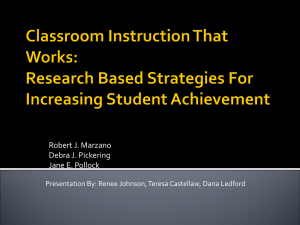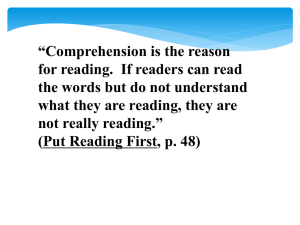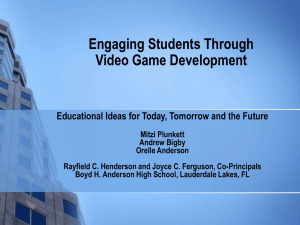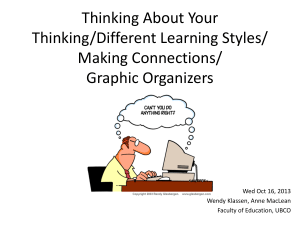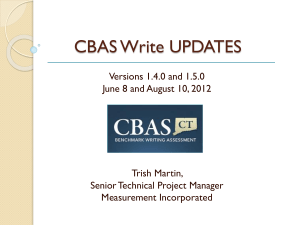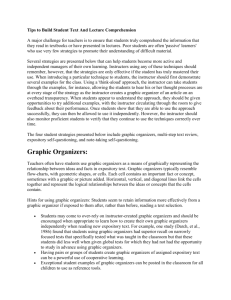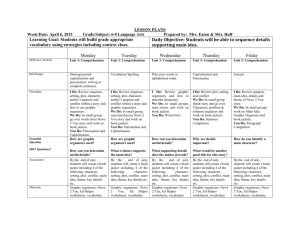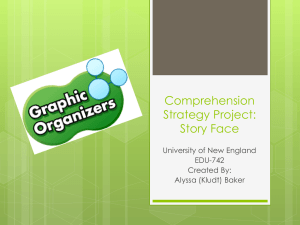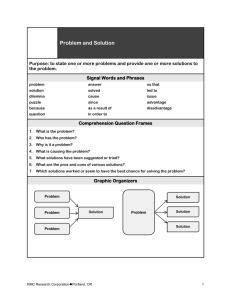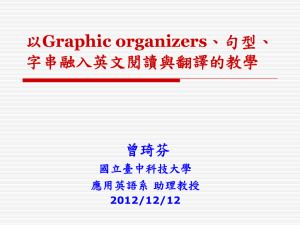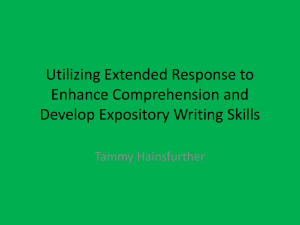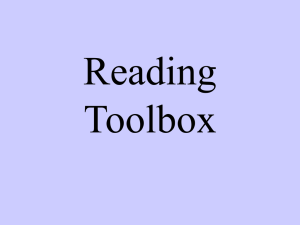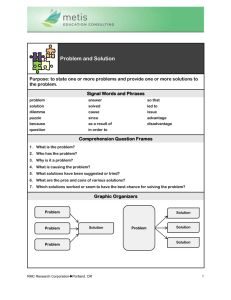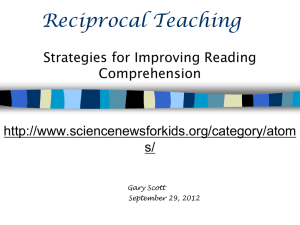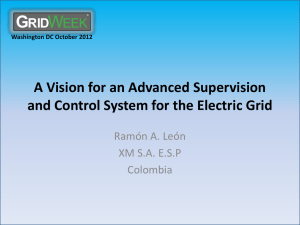READING & WRITING STRATEGIES
advertisement
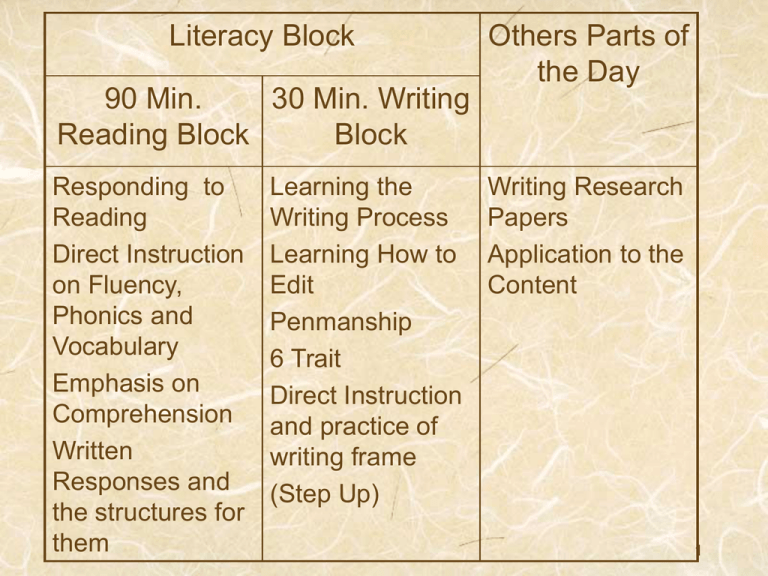
Literacy Block 90 Min. 30 Min. Writing Reading Block Block Responding to Reading Direct Instruction on Fluency, Phonics and Vocabulary Emphasis on Comprehension Written Responses and the structures for them Learning the Writing Process Learning How to Edit Penmanship 6 Trait Direct Instruction and practice of writing frame (Step Up) Others Parts of the Day Writing Research Papers Application to the Content 1 Written Responses within Reading Instruction Building Bridges to Deeper Comprehension 2 “A failure to recognize that composing and comprehending are process-oriented thinking skills which are basically interrelated… impedes our efforts not only to teach children to read and write, but our efforts to teach them how to think.” (Squire, 1983, p.581) 3 COMPARISION OF READING AND WRITING PROCESSES What Readers Do What Writers Do Step 1 PreReading Step 1 Prewriting Expectations are cued by Previous reading/writing experiences Format of the text Purpose for reading Audience for reading Expectations are cued by Previous reading/writing experiences Format of the text Purpose for reading Audience for reading Step 2 Reading Step 2 Drafting Use knowledge about : the topic reading literature language systems Use word identification strategies Use comprehension strategies Monitor reading Construct meaning Use knowledge about: the topic writing literature language systems Use transcription strategies Use meaning making strategies Monitor reading Construct meaning 4 Step 3 Responding Respond to the text Step 3 Revising Respond to the text Interpret meaning Interpret meaning Clarify misunderstandings Clarify misunderstandings Expand ideas Expand ideas Step 4 Exploring Examine the impact of words and literary language Step 4 Exploring Identify and correct mechanical errors Explore structural elements Review paragraph and sentence structure Compare the text to others Step 5 Applying Go beyond the text to extend their interpretations Step 5 Publishing Produce the finished copy of their compositions Share projects with classmates Share their compositions with genuine audiences Reflect on the reading process Make connections to life and literature Value the piece of literature Feel success Want to read again Reflect on the writing process Value the composition Feel success Want to write again 5 Understanding Why Writing Improves Comprehension Helps clarify, organize and refine thoughts Involves the construction of meaning (Wells,1993,Brookes, 1998) Purposeful and structural in shaping the learner’s experience (Tierney &Pearson, 1983) Builds links between: Text Text Text Text World Self 6 Understanding Why Writing Improves Comprehension Writers respond to text as they compose Readers need to respond to what they are reading to interpret text Writing expresses your own personal insight into a text Langer & Flihan, 2000 7 Using Written Responses to Enhance the Understanding of Text Pair writing activities with decoding, vocabulary, fluency and comprehension for higher level of understanding. Use explicit and direct instruction to introduce task, product or genre. Limit instruction of genre to narrative, expository, persuasive. 8 Using Written Responses to Enhance the Understanding of Text Have students respond or reflect on text through written assignments. Use comparisons of: • text to text • text to self • text to world Use writing to gain deeper understanding of the text. Focus on informational summaries, personal responses to literature and quality responses to Langer & Flihan, 2000 questions. 9 Types of Written Responses Dictation- sound, word or simple sentence dictation Simple answers- one to two words or a short sentence Short answer- is used when the question needs a simple concise response. Extended answer- used for more detailed explanations or comparison of text 10 Know Your Instructional Target! Story Target Target Target Strategies 11 Reading & Writing Strategies Instruction Before During After 12 Instructional Framework Vocabulary Fluency Comprehension Writing Before Word relatedness Illustrate & associate Model fluent reading Cold timings Predicting events in story Group writing activity on predictions During Reteach words Oral partner reading Summarizing Questioning Get the Gist Word maps Content charts Fast phrases Graphic Sticky notes organizers After Questioning Review predictions Written response to G.O. and QAR 13 R & W STRATEGIES SUMMARIZING QUESTIONING 14 Summarizing • Story Frames • Get The Gist • Graphic Organizers • Narrative and Expository 15 Story Frames Provides written language structure Great for the primary grades (1-2) Benefits ELL & Special Ed students Types: Character analysis Plot summary Setting Story problem 16 Get The Gist Effective summarizing strategy. Improves understanding and memory of reading material. Students monitor their comprehension by summarizing key information. 17 Graphic Organizers •Graphically represented ideas & relations. •Illustrate concepts and interrelationships among concepts in a text using diagrams or pictures. •Reading tools used to organize, clarify and interpret what is being read. •A means of getting to end, not the end result. 18 Responses To Graphic Organizers Express graphically represented ideas & concepts and their relationships in writing. Utilizing the information gained from the organizer to construct a reflective thought in writing. Written response’s framework and/or structure should reflect the nature of the graphic organizer. 19 Graphic Organizers For Narrative Text Story Elements Chart (p. 31) Story Structure/Grammar Map (p. 45) Find & Connect The Features Chart (pp. 35-39) Think Links (pp. 15-16) Compare And Contrast (p. 19) 20 Graphic Organizers For Expository Text Main Idea Chart (p. 23) Note Taking Organizer (p. 26) Mind Map (p. 29) Venn Diagram 21 Questioning •Types-short answer or extended response. •Higher level type of questions •Provide students with opportunities to make connections and think broadly about a topic. •Predict story features and events. •Reflect on what they’ve read by integrating their prior knowledge with text-based information. 22 Questioning & Text • Narrative Text: 1) Who, What, When, Where & Why? 2) Solution to the problem. 3) What will happen next? • Expository Text: 1) Does this make sense? 2) What have I learned so far? 3) What questions do I still have? 23 READING & WRITING ACTIVITY • Choose a story from the teacher’s manual to use. • Select 2 “TARGETS” that will be the used for instruction. • Decide if the strategy would work best in the Before, During or After section of the lesson. • Select a writing response that will expand the strategy’s focus. 24 Assessment of Writing to Learn It is all about the Quality of the Response for Extended Response Use a rubric that focuses on Ideas, Organization and Conventions Ask yourself: • Is the content accurate? Is it substantial, specific and /or illustrate the target? • Does the response follow the structure? (Frame, summary structure, question responses) • Are the conventions visible and do not interrupt the flow of the writing? 25 Assessment of Writing to Learn Extended Written Responses to Reading Rubric 4 Shar p d istinct focus Substantial sp ecific and illustrate content Obvio us or ganiza tio n Few mechani cal error s 3 Ad equ ate focus Sufficient content App rop riat e or ganiza tio n Mechani cal an d us ag e error s no t severe enou gh t o interfer e wit h writer’s pu rp ose 2 Inconsis tent focus Supe rficia l content Con fuse d or ganiza tio n 1 Absence of focus Absence of relevan t cont en t Absence of or ganiza tio n Mechani cal and Mechani cal and us ag e error s so us ag e error s that severe that t he serio us ly writer’s idea s ar e interfer e wit h the d ifficu lt to writer’s pu rp ose u nd er stand 26
